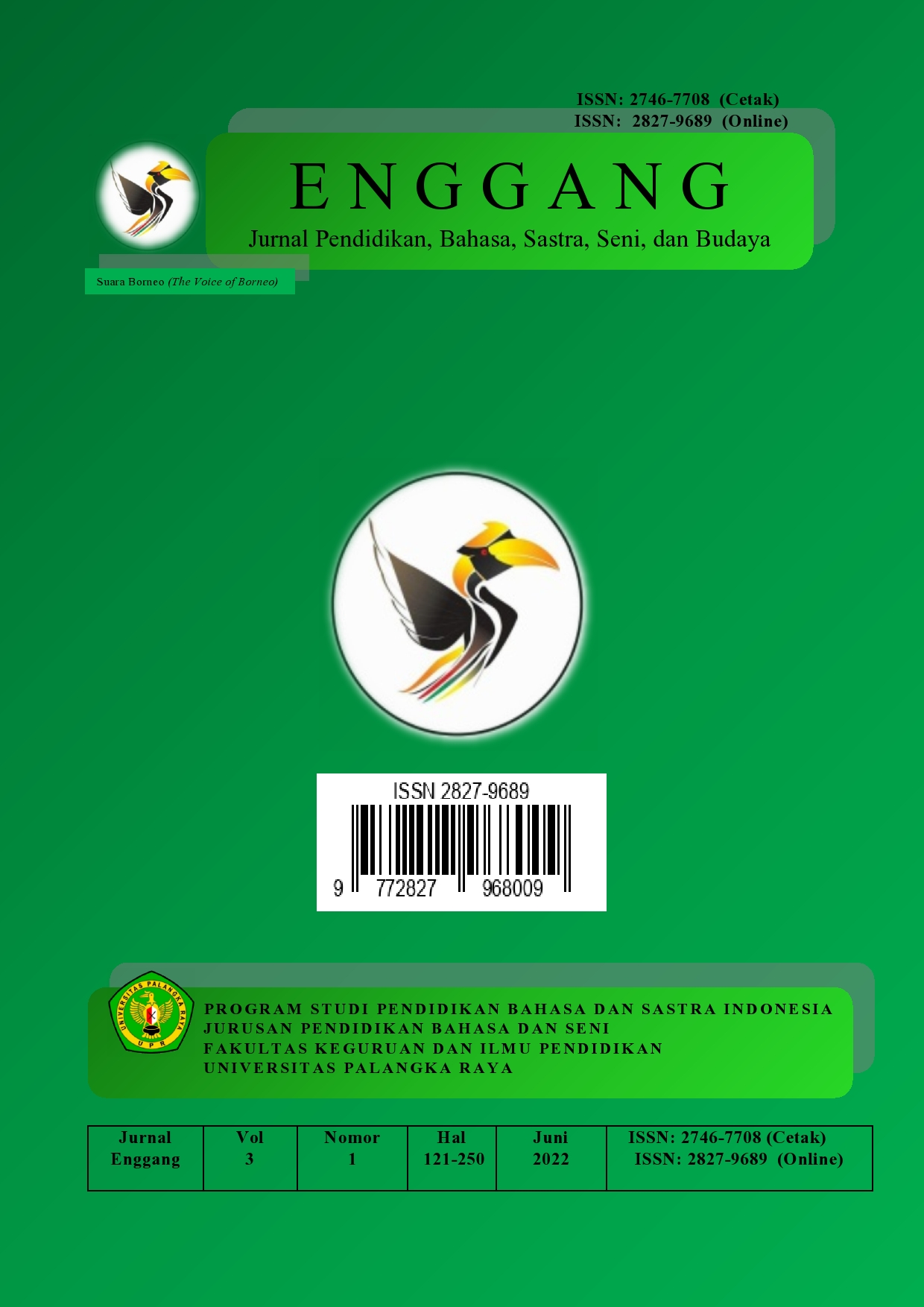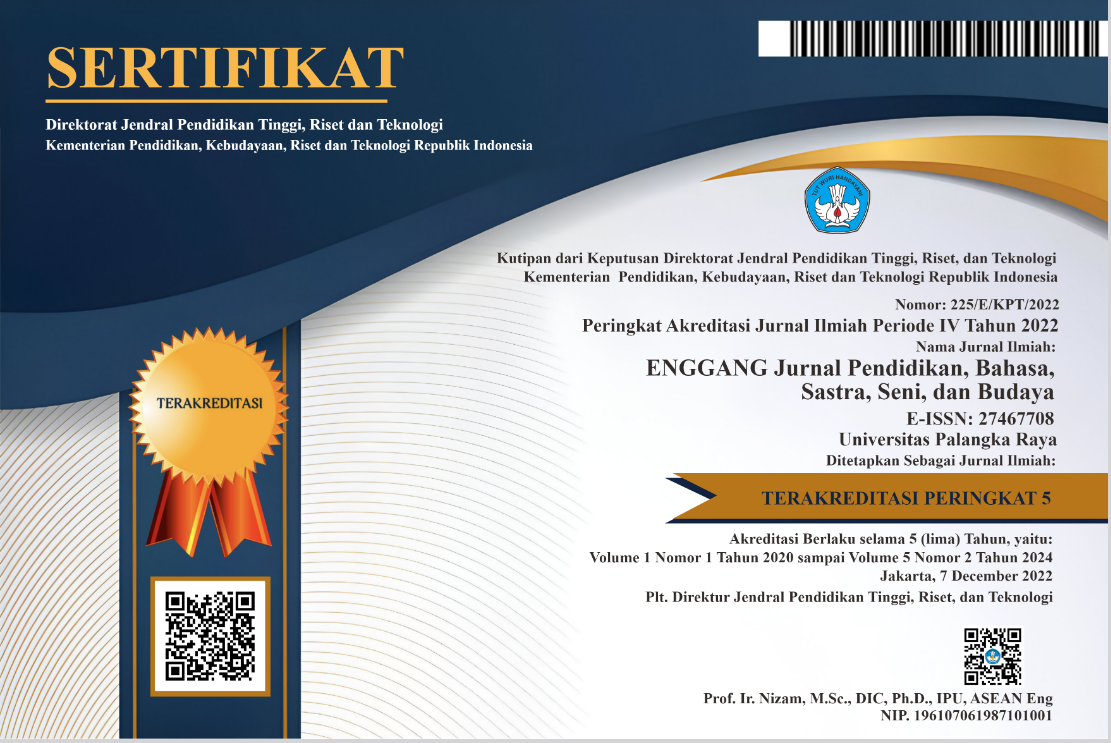REKACIPTA MITE PUTRI MAYANG SEBAGAI BENTUK PENGEMBANGAN SASTRA LISAN DAYAK MAANYAN DI KABUPATEN BARITO TIMUR
DOI:
https://doi.org/10.37304/enggang.v3i2.11715Keywords:
The reinvention, the myth of Putri Mayang, and oral literatureAbstract
The reinvention of Mite Putri Mayang as a form of development of Dayak Maanyan oral literature in East Barito Regency is a form of innovation to revive the meaning of each story in it through the form of a short story. This research aims to create the Putri Mayang myth as a form of developing Dayak Maanyan folklore in East Barito Regency through short story writing. The research method used is the Participatory Planning and Research (PPR) research method, data analysis is carried out in a qualitative descriptive manner, so that the presentation only takes the form of an explanation in the form of words. Data collection was carried out by determining the research object, the material object was the oral literature myth of Putri Mayang, while the formal object was Ruth Finnegan's oral literature theory. Search for data in two ways, namely literature and field. The results of research regarding the Putri Mayang myth of the Dayak Maanyan tribe in East Barito Regency, it can be concluded that this story reflects local leadership without highlighting the superiority of the Banjaran or the inferiority of the Kedayakan. Putri Mayang Sari's leadership focuses on people's welfare, food security, and the implementation of the traditional Dayak Maanyan government system. This mythical story also contains religiosity, social, political and economic values in ritual practices, inter-religious tolerance, an inclusive government system, and an emphasis on food security in the Maanyan Dayak community. The process of recreating the short story Putri Mayang shows creative efforts in reinterpreting the myth. Even though there are variations in interpretation, some short stories are still tied to the setting and characters of the original myth. For example, "Parang Maya" carries regional values while giving a contemporary touch. The creation of short stories is a refreshing form of creativity in the cultural heritage of the Dayak Maanyan people.
Downloads
References
Danandjaja, James. 1986. Folklor Indonesia, Ilmu Gosip, Dongeng, dan Lain-lain. Jakarta: Grafiti.
Effendi, Rustam. 2011. Sastra Banjar: Teori dan Iterprestasi sebuah Buku Ajar. Banjarbaru: Scripta Cendikia.
Fauzan, Ahmad Muflih. 2009. Tradisi Tiwah Masyarakat Muslim Suku Dayak Ngaju (Studi di Kecamatan Mentaya Hulu Kabupaten Kotawaringin Timur
Propinsi Kalimantan Tengah). Skripsi. Malang: Universitas Islam Negeri Maulana Malik Ibrahim.
Nurgiyantoro, Burhan. 2016. Sastra Anak: Pengantar Pemahaman Dunia Anak.
Yogyakarta: Gadjah Mada University Press.
Banda, Maria Matildis, 2015. “Tradisi Lisan Sa Ngaza dalam Ritual Adat dan Ritual Keagamaan Etnik Ngadha di Flores.” Disertasi. Denpasar: Program Kajian Budaya Fakultas Pascasarjana Unud. Barker, Chris. 2009. Cultural Studies: Teori .an Praktek (terj. Noerhadi dan Sihabul Millah
Hoed, H. Benny 2008. “Komunikasi Lisan sebagai Dasar Tradisi Lisan” (dalam Metodologi Kajian Tradisi Lisan. Pudentia, MPSS, ed., Jakarta: Yayasan Obor dan ATL, hlm 183-193). Ikram Achadiati, 2008 “Beraksara dalam kelisanan” dalam Metodologi Kajian Tradisi
Tol, R dan Pudentia. 1995. “Tradisi Lisan Nusantara: Oral Traditions from the Indonesian Archipelago, A Three Directional Approach” (dalam Warta ATL No. I/01-Maret 1995, hlm 12-16).
Mardiana, D., & Fauzi, I. (2022, May). Makna Kultural Benda-benda Bersejarah Peninggalan Kesultanan Kutaringin: Sebuah Pendekatan Semantik Pedagogis. In PROSIDING SEMINAR NASIONAL PENDIDIKAN, BAHASA, SASTRA, SENI, DAN BUDAYA (Vol. 1, No. 1, pp. 247-262).
Misnawati, M. (2023). Melintasi Batas-Batas Bahasa Melalui Diplomasi Sastra Dan Budaya: Crossing Language Boundaries Through Literary And Cultural Diplomacy. Pedagogik: Jurnal Pendidikan, 18(2), 185-193.
Misnawati, M. (2022). Teori Ekopuitika untuk Penelitian Sastra Lisan. Drestanta Pelita Indonesia Press.
Misnawati, M., Poerwadi, P., Nurachmana, A., Veniaty, S., Lestariningtyas, S. R., Christy, N. A., ... & Rahmawati, S. (2022). The Ekopuitika Theory. International Journal of Education and Literature, 1(1), 54-62.
Misnawati, M., Maysani, D., Diman, P., & Perdana, I. (2022). Keindahan Bunyi Sebagai Identitas Kultural Masyarakat Dayak Maanyan Dalam Sastra Lisan Tumet Leut. Drestanta Pelita Indonesia Press.
Vansina, Jan. 1985. Oral Tradition as History. London: James Currey. Nairobi: Heinemann Kenya.
Vansina, Jan. 1985. “Oral Tradition as History,” James Currey Publishers. ISBN 0 – 85255 – 007-3, 9780852550076
Keesing, Roger M. 1999. Antropologi Budaya: Suatu Perspektif Kontemporer.(Samuel Gunawan, Pentj). Jakarta: Erlangga.
Sdalb, Mahudi. 2008. Budaya Dayak Maanyan:Idjame/Pembakaran Tulang Alla
Nagben di Murutuwu/Paju Epat. Tamiang Layang: Dinas Kebudayaan dan Pariwisata.
Sibarani, Robert. 2004. Antropolinguistik: Antropologi Linguistik atau Linguitik Antropologi. Medan: Penerbit Poda.













